Longitudes
Longitudes cuts across Latitudes’ projects and research with news, updates, and reportage.
Latitudes’ "out of office" 2021–22 season
Mon, Aug 1 2022As the summer break creeps up on us with a weary smile in the already sweltering heat-and-humidity of Barcelona, it’s once again time for our annual looking-back post wrapping up the last twelve months of Latitudes’ activities, a period of time which includes the most extensive exhibition we’ve made to date in Spain: MACBA’s “Panorama 21. Notes for an Eye Fire”.
In thinking of how to pen this little introduction to a compilation that’s an ending of sorts, our thoughts turned back to a request we received in February from Shimmer, the exhibition space in Rotterdam, The Netherlands. The artist Jo-ey Tang was creating a new version of a project which would comprise an endless loop of the favourite endings of films suggested by friends of Shimmer. Our contributions: Mariana chose Giuseppe Tornatore’s Cinema Paradiso (1988) and Max, the Coen Brothers’ The Big Lebowski (1998).
In the ending of Cinema Paradiso, Salvatore watches a final bittersweet gift from Alfredo: a reel with all the romantic scenes that had been censored from the cinema. Looking back brings happy nostalgia and a chance to make peace with the past.
And to paraphrase the Coens’ Stranger... well, that about does her, wraps her all up. Things seem to have worked out pretty good. Parts, anyway. Aw, look at me, I’m ramblin’ again. Well, I hope you folks enjoyed yourselves. Catch ya later on down the trail...
This end-of-the-season post is the fourteenth in the “out of the office” series published every end of July to mark the beginning of our holidays (or the desire of having one). Check earlier posts from 2008–9, 2009–10, 2010–11, 2011–12, 2012–13, 2013–14, 2014–15, 2015–16, 2016–17, 2017–18, 2018–19, 2019–20 and 2020–21 seasons. All photos are by Latitudes unless stated otherwise in the photo caption.
x
The September 2021 issue of frieze magazine includes a review of David Bestué's exhibition at Centre d'art La Panera, published online last May.
via @marcnavarro facebook.
Above photo by Hiuwai Chu. Below are co-curator Hiuwai Chu and Rasmus Nilausen under Felix Gonzalez-Torres’s “Untitled (Perfect Lovers)” (1987–1990).
13 September 2021: Boules of oak (Quercus canariensis), cedar (Cedrus sp.) and pine (Pinus pinea) arrive at TMDC in La Verneda, the material for a new iteration of Nyamnyam and Pedro Pineda’s project ‘A quatre potes’ (2014–ongoing) that will be presented in MACBA's exhibition “Panorama 21. Notes for an Eye Fire”.
As the exhibition wall text pointed out, the project is “founded on the principle that in order to share a meal or have a discussion you first have to build a table to sit at. Leading up to and during the exhibition, a group of people with diverse roles within the MACBA are participating in a series of co-design and collaborative making workshops that began with the purchase of several tree trunks from a sustainable forestry initiative in the nearby Montnegre massif.”
During the next week, the trees would be “transformed into planks and laths at the shared machine shop TMDC, this locally sourced wood is being adapted in the gallery by the museum workers into a range of tables, benches, and other structures. This furniture acts as a mediator between natural and human resources, creating different social settings throughout the course of the exhibition and becoming the scenography and motive for a series of discussions around practices of collectivity and cultures of sustainability within and beyond the institutional walls.”
Photo: TMDC
22 September 2021: Conversation with Jorge Satorre as part of the series “Dialogues with artists from the Contemporary Art Collection” and within the framework of “El tiempo en las cosas”, an exhibition curated by Tatiana Cuevas at the Museo Amparo in Puebla, Mexico.
Due to work and time differences, the talk was recorded a few days earlier. The conversation revolved around the production process of "The Erratic. Measuring Compensation", a work included in Satorre's exhibition and commissioned by Latitudes as one of the ten projects produced throughout 2009 in the public space of the Port of Rotterdam, The Netherlands.
‘The Erratic’ is also featured as the September 2021 Cover Story on our homepage.
27 September–19 October 2021: Three weeks installing the first edition of MACBA’s Panorama triennial, “a new series of transdisciplinary projects that reflects the museum’s desire to deepen its collaboration and dialogue with local artists and cultural agents”. The inaugural project of Panorama is the group exhibition “Notes for an Eye Fire” which occupies MACBA's top floor. During this first install week, efforts centred on shipping, registering, and installing Rasmus Nilausen’s “Theatre of Doubts” (2021) at one end of the museum and Stella Rahola Matutes’ “Fig Juice” (2020) at the other end, while walls were being painted, final sound checks were done and artworks were finally arriving at the museum.
Stella Rahola Matutes and Alex Castro (Conservator, MACBA) photo-documenting Stella's work before installation.
Xavi (install crew of Coolturart) installed one of Stella's glass figures.
Stella Rahola Matutes and Xavi (install crew of Coolturart) carefully installed Stella’s “Fig Juice”.
Lluis Roqué (Conservator at MACBA) documented Rasmus Nilausen’s paintings.
Rasmus Nilausen’s paintings (walls) and Stella Rahola Matutes glass pieces and chains (tables) are analysed and registered by the conservation team before installation.
While Rasmus's wooden supports are being assembled, the improvised office at the museum landing is busy checking the “final-final-final” version of the wall labels, intro text and the leaflet.
First of Rasmus Nilausen’s large paintings (1 of 49) is finally up, supervised by Eva Font (left, space coordinator of the exhibition, MACBA), Alex Castro and Lluís Roqué (centre, Conservators, MACBA), ARAM staff (the carpenters that produced the wood supports) and the install crew of Coolturart.
Nilausen's “Wax Cabinet” (2021, 300 x 205 x 6cm, oil on linen) being moved and hung (below).
Ongoing metamorphosis in the largest exhibition space on the second floor.
Last sound checks with Pablo Miranda and Laia Estruch.
R. Marcos Mota of El Palomar doing a mock-up of the archival material to be presented in vitrines.
Meanwhile, nyamnyam and Pedro Pineda’s tree is sent to Lleida to be fireproofed.
To end the first week, Antoni Hervàs’s “La Meiers” (above) arrives at the museum from La Escocesa, as well as Claudia Pagès’s silkscreened and fireproofed cardboard from Capellades (two below), alongside the structure manufactured by Tallers Soteras to hold the LED panels shipped from Shenzhen that forms her new commissioned video installation “Gerundi Circular” (2021) – soundtrack here.
Week 2 begins with the exciting placement of Antoni Hervàs’s “La Meiers” becoming the entrance to the exhibition.
Meanwhile, Arash Fayez’s wall is almost fully painted in the nearby gallery...
...and Claudia Pagès starts installing the LEDs around the circular metal structure.
Claudia amidst the cable maze.
Coolturart team fixing the circular screen to the ceiling.
First sound and image test of El Palomar’s “Schreber is a Woman” with R. Marcos Mota. The amazing soundtrack that accompanies the video can be listened to here, on Spotify or you can also purchase the 12'' vinyl edition.
Drawing of the structures that hold Laia Estruch’s “Ocells Perduts” net structure drawn by the museum architecture department, placed below by RMG Redes.
Vinyl placed in Plaça dels Àngels promoting MACBA’s programme this trimester includes two sketches by Laia Estruch of her “Ocells perduts” piece.
Habemus Ruta de Autor newspaper!
Parallel to all the activities going on, Hervàs continues customising “La Meiers” to fit what will become the entrance to the exhibition.
Eulàlia Rovira’s replica of Richard Meier’s signature column arrives at the museum. Since we have all the hands and machinery ready, it soon goes up.
Eulàlia shares instructions on how to assemble the yellow supports.
Laia Estruch’s large red net slowly goes up and takes shape.
Photo: Hiuwai Chu
Making a selection of Eulàlia Rovira’s new photo collages.
Hervàs in progress.
Technical difficulties. Please bear with us.
Laia is finally able to go up the net and do her first and only rehearsal. High expectations from artists colleagues, curators and staff observing below.
Final calculations before hanging Arash Fayez’s 310 papers documenting his migrant “limbo” status in the US and Europe.
Meanwhile, in the Teatre Molino in Paral·lel, Antoni Hervàs’ begins “La Meller”, the second part of his contribution to Panorama 21: a 27-metre mural in which Hervàs and his collaborator Pau Magrané unfold a chronicle of the neighbourhood's beloved theatres and venues, both past and present, resulting in "a frieze-carousel" where authors, actors and actresses such as Violeta la Burra, Escamillo, Johnson, Pierrot, Ángel Pavlovsky, float timelessly intertwined by boas.
(Above and below) Pau Magrané and Antoni Hervàs working on the graffiti. Photo: Eva Carasol.
Tecnodimensión testing Laia Estruch’s wind sock before mounting it on the wall.
Adrian Schindler goes through the ephemera that will be displayed as part of his installation.
Installing Rosa Tharrats’s work in the atrium/corridor space.
Placing the newspaper spread by Ruta de Autor to check heights.
Entrance / Exit of the exhibition in progress.
Marria Pratts’s “Sento una música dintre del cap (I Hear Music Inside My Head (Transformation of a Blurry Thought)), 2021.
Antoni Hervàs’ “La Meiers” is almost there.
Installing Rosa Tharrats’s work in the atrium/corridor space.
Iñaki of nyamnyam and Pedro Pineda placing the fireproofed wood boules (detail below)
Max Andrews, Hiuwai Chu and Aleix Plademunt checking the measurements between the 18 images.
Important message from Antoni Hervàs: “Do not paint in white!! (please) You were right, thank you. NO!” :-)
As the day ends we leave the museum and take a gander at the lighting colours on Rosa Tharrats’s installation as the days get shorter.
Entrance vinyl is in place and final cleaning.
In the 16th dispatch, curator Marie-Nour Héchaimé navigates Beirut with artist-filmmaker Panos Aprahamian a year after the August 2020 explosion, when hundreds of tons of ammonium nitrate stored for six years without safekeeping in the port of the Lebanese capital were set on fire and exploded. The blast killed more than 200 deaths, 6,500 wounded, 300,000 displaced, and great destruction in the city. “I say that I am living with ghosts—of people, places, memories, stories”, she reflects. “He answers that Beirut is disintegrating in front of our very eyes.”
Part of the series produced by KADIST and edited by Latitudes since 2016, exploring the chartered itinerary as a format of an artistic encounter between curators and artists.
21 October 2021: Press conference and evening opening of the exhibition “Panorama 21: Notes for an Eye Fire” at MACBA. We realise this is the first time all the artists and curators are able to meet IRL.
Final clean-up before the press conference.
Photo: Pedro Pineda.
Participants of “Panorama 21. Apunts per a un incendi dels ulls” (nyannyam and Ana Domínguez are missing) posing for the press. Photo: Hiuwai Chu
(Above and three below) Press conference in MACBA's atrium, 21 October 2021. Photos: Miquel Coll.
(Left to right) Max Andrews (Latitudes), Hiuwai Chu (Head of Exhibitions, MACBA), Elvira Dyangani Ose (Director, MACBA) and Mariana Cánepa Luna (Latitudes) during the press conference, 21 October 2021. Photos: Miquel Coll.
Participating artist Eulàlia Rovira responded to Carolina Rosich's questions for TV3 news. Photo: Hiuwai Chu.
(Above and nine below) Opening of the exhibition “Panorama 21. Apunts per a un incendi dels ulls” at MACBA. Photos: Miquel Coll.
Photo by Hiuwai Chu.
19 November 2021: First change of Nyamnyam and Pedro Pineda’s “A quatre potes” (2014–ongoing), a scenography presented as part of MACBA’s exhibition “Notes for an Eye Fire”.
20 November 2021: First of four open rehearsals of “Ocells perduts” [Stray Birds] (2021) by Laia Estruch presented as part of MACBA’s exhibition “Panorama 21. Notes for an Eye Fire”.
25 November 2021: Jury of the 5th edition of DART Festival, alongside the film critic Quim Casas and the journalist Ianko López, and festival team members Enrichetta Cardinale and Silvana Fiorese, to choose the best national and international documentary in the competitive section.
2 December 2021: Parlem de...cabaret, a guided visit led by participating artist Antoni Hervàs as part of MACBA’s exhibition “Panorama 21. Notes for an Eye Fire”. The audio was edited and later made available on Latitudes’ Soundcloud.
Audio of Toni’s 1h guided tour on Soundcloud.
Second part of Antoni Hervàs’ itinerary we stopped at the bar Atlanta FC in Rambla del Raval, where Hervàs explained the origins of his proposal for his two-part project for MACBA's exhibition: the 1980s board game “El Chino” (as part of El Raval neighbourhood was formerly known). Hervàs also shared a selection of preparatory drawings that we would later see on the wall he and Pau Magrané graffitied in Paral·lel.
The itinerary ended in front of Teatre Arnau in Paral·lel, where Toni Hervàs and his collaborator Pau Magrané painted the wall that protects the theatre during its restoration. Hervàs’ mural honours the cabaret history of Paral·lel’s nightlife, its cabaret, bars, and actresses.
9 December 2021: Parlem de...Anecdotes to be Forgotten, a performative walkthrough by Arash Fayez as part of MACBA’s exhibition “Panorama 21. Notes for an Eye Fire”.
14 December 2021: Ràdio Web MACBA publishes a podcast with El Palomar (in Spanish) where they discuss “Schreber is a Woman” (2020) their most recent film produced for the 11th Berlin Biennial and presented for the first time in Spain as part of MACBA’s “Apunts per a un incendi dels ulls”.
Phone view of → http://incidents.kadist.org/Riga
17–19 December 2021: After months of uncertain planning, Paul O'Neill, director of PUBLICS, is able to visit Barcelona to meet Laia Estruch and attend the second rehearsal of her work ‘Stray Birds’ (2021), a new commission produced for the exhibition “Notes for and Eye Fire” at MACBA, and supported by PUBLICS.
January 2022: Visiting MACBA’s exhibition with long-time artist friend Lara Almarcegui based in Rotterdam.
13 January 2022: Hablemos de... Passió i cartografia per a un incendi dels ulls, a sung visit by poet Gabriel Ventura and flamenco cantaor Pere Martínez, reading and singing poems written for the occasion by Gabriel. Pell de gallina!
Gabriel started the itinerary under Antoni Hervàs’s work “La Meiers”, a work commissioned for MACBA’s exhibition, that became the entrance and the exit to the neighbourhood.
17 January 2022: Exactly a year after its closure, we receive a copy of the publication accompanying the exhibition “Things Things Say”, which took place at Fabra i Coats: Centre d'Art Contemporani de Barcelona between October 2020 and January 2021. We are elated to finally have it in our hands!
A discussion around “A quatre potes”, the project presented in the exhibition by nyamnyam and Pedro Pineda, around forest management, design as an investigative tool, and the limits of the museum with the participation of Lídia Guitart (forest engineer), Curro Claret (industrial designer), Ingrid Guardiola (writer, cultural researcher and Director of Bòlit, Centre d'Art Contemporani), the artists, exhibition curators, and workshop participants. This activity was part of Education from Below, a project with the support of Creative Europe's programme of the European Union Creative Europe.
The setting for the event was rearranged the evening before with workshop participants (MACBA staff that have volunteered in a number of workshops cutting the wood planks, arranging them in the exhibition space, and changing the set-up on a monthly basis) following the principle and the spirit of the project that “in order to have a discussion we need a table”.
(Above and below) The before and after, seating is ready for tomorrow's open discussion. Photos: Ariadna Rodriguez (nyamnyam).
Designer Curro Claret brought in an earthenware cup used in India to drink tea before boarding on a train. Once used the cup is thrown out the window and hence, naturally recycled into the landscape, an “evident example of what circular economy is and should be”. Plastic cups took over but pollution along the tracks was so bad the government encouraged tea makers to go back to earthenware.
Ingrid Guardiola began mentioning Octavi Comeron’s “La Fábrica Transparente” and how institutions’ obsession with transparency, in turn, generates opacity from within those institutions or, as Peter Sloterdijk warned, is an example of cynical transparency. Then moved on to reflect on how institutions could learn from forest’s entropy and efficiency and how exceeding energies could be used within institutions.
Lidia Guitart, a forest engineer from the Associació Propietaris Forestals del Montnegre i el Corredor (from where nyamnyam’s wood was originally purchased) discussed perceptions of forest management in Catalunya in relation to Finland (the leader in paper pulp supplier) and shared some interesting data: 60–70% of Catalunya is forest, yet 80% of that is in private hands.
The 2h session was punctuated by printed cards with words/concepts triggering several subjects related to each of the guests' practices which were then chosen at random to encourage interlinking rather than monothematic presentations.
2 February 2022: Ràdio Web MACBA publishes a podcast with Claudia Pagès (in Spanish) where she discusses “Gerundi Circular” (2021) a new video-installation commissioned for MACBA’s “Apunts per a un incendi dels ulls”. The work is presented in her solo show “Abajo el puerto suena nino-nino, y yo arriba pipí” in Madrid’s gallery The Ryder in June 2022.
The book includes a preface by art centre director Joana Hurtado Matheu, new texts by Latitudes, a text-based intervention by participating artist Eulàlia Rovira, and texts on each exhibited work also written by Latitudes.
22–25 February 2022: Trip to Madrid for ARCOmadrid. Max previewed “What to see during this year's ARCOmadrid” for frieze. Worth adding to the list is the joyous retrospective of Bruno Munari at Fundación Juan March, the catalogue currently on our desk.
27 February 2022: After a four-month run, the exhibition ‘Notes for an Eye Fire’ comes to an end at MACBA. Here is a selection of the most relevant reviews, clips from television and radio programmes that have covered the show, and of course photo documentation.
As a poetic colophon of the exhibition, the publication “Passió i cartografia per a un incendi dels ulls” was released. It includes a new poem in three movements by exhibition participant Gabriel Ventura, and photos of the works in the museum galleries documented by Roberto Ruiz, Eva Carasol, Miquel Coll and Latitudes.
2 March 2021: Ràdio Web MACBA publishes a podcast with Panorama artist Marc Vives (85'22'' in Spanish) where he discusses his practice and for MACBA’s “Apunts per a un incendi dels ulls”.
10 March 2022: Lecture about our curatorial practice and on the recently concluded MACBA exhibition “Panorama 21. Apunts per a un incendi dels ulls” to fourth-year students at the Fine Arts Department of the Universitat de Barcelona. The student Rita Duarte Lli tagged us during our presentation, so we asked if she would mind sharing the mental map she drew during the session, see below.
Mental mapping of the session courtesy of Rita Duarte Lli (@ritinacaipirina ) following the @cursogenius.es technique.
We donated three more publications (“Passió i cartografia per a un incendi dels ulls” published by MACBA in 2022, Lola Lasurt’s “Joc d'infants” published by La Capella in 2020 and Anna Moreno’s “The Drowned Giant” also published by La Capella in 2017) to PUBLICS Library, joining the first 5kg we donated back in 2019. These will soon be joined by the publication of the exhibition “Things Things Say” published by Fabra i Coats: Centre d'Art Contemporani de Barcelona. You can search here.
[Note that not all the results are under “Latitudes”, others are under “Max Andrews” or “Mariana Cánepa Luna” as writers]. PUBLICS library is the third location where the whole set of Latitudes’-edited publications sleep, alongside the Library of the MACBA Study Centre, Barcelona, and the Paul D. Fleck Library & Archives, The Banff Centre, Canada.
On March 15, we had the chance to do an adaptation of our itinerant “Near-Future Artworlds Curatorial Disruption Foresight Group” workshop (earlier iterations took place in Bari, San Francisco, Birmingham, and Barcelona), this time under the “Professional Skills for Artists” class led by Prof. Suzanne Mooney. We met around fifteen MFA students in the new Sörnäinen campus building of the Academy of Fine Arts of the Uniarts Helsinki. Throughout our 2-hour encounter, issues such as the lack of free-of-charge exhibition spaces for younger artists or affordable studio spaces emerged when reflecting on the weaknesses of Helsinki’s art ecology and how could these needs be “hacked”, improved, and ideally eliminated.
30 March 2022: frieze.com publishes Max Andrews’ review of Bruno Zhu’s exhibition “I am not afraid” at Cordova in Barcelona. The frieze summer issue will include a printed version.
31 March 2022: Press trip to Córdoba on the occasion of “Abundant Futures”, the inaugural exhibition Thyssen-Bornemisza Art Contemporary (TBA21) organises in C3A Centro de Creación Contemporánea de Andalucía, Córdoba, as part of their three-year-long collaboration agreement.

(Above) Ceramic pieces by Asunción Molinos Gordo. (Below) Installation by Ernesto Neto.
(Above) Installation by Daniel Steegman Mangrané.
(Below) "Apagón" (2017) by Allora & Calzadilla, included a performance activated in the opening evening performed a capella by a local choir.
(Above) Installation view with works by Ai Weiwei (left) and Regina de Miguel (right).
1 April 2022: New cover story on Latitudes’ home page on Laia's performance “Mix” and PUBLICS & Latitudes match.
8 April 2022: Curatorial studio Shimmer in Rotterdam (first Paraguests of PUBLICS) inaugurate “More More More Than Than Than Lovers Lovers Lovers More More More Than Than Than Friends Friends Friends” a “looped supercut of film endings, selected by those who Shimmer admires. A compilation of final scenes and musical accompaniments with the closing credits, these endings are experienced repeatedly, back to back.” Max and Mariana of Latitudes each selected a film ending for the occasion (ref. at the beginning of this post).
18 April 2022: 18th dispatch of Incidents (of Travel) is live! Narration and photography by curator Xenia Kalpaktsoglou and artist Pegy Zali from Attica, Greece. Xenia and Pegy conceive an itinerary and a screenplay-like commentary that takes us through the Attica peninsula, from a mysterious inscription sprayed at the site of a railway sabotage that transpired near Piraeus Port in 2010, to the vestiges of an enormous wildfire that consumed the forest around Alepochori in 2021. Produced by KADIST.
May 2022: Discussing details with Laia Estruch and Helsinki-based writer and curator Irina Mutt for touring Estruch’s “Ocells Perduts (Stray Birds)” (2021–22) to Helsinki.
Early June 2022: While visiting Madrid for work-related appointments, we had a chance to peak into Rosa Tharrats’s first solo show at Galería Ehrhardt Flórez before it opened and to visit Aleix Plademunt’s largest solo show to date at Sala Canal Isabel II. Both artists were recently featured in “Panorama 21. Notes for an Eye Fire”, and other “Panorama alumni” (Laia Estruch, Adrian Schindler, Arash Fayez and Gabriel Ventura) are also currently or soon exhibiting in Madrid, as featured in this post.
“Entrando en la obra” (Entering the Work, 2018) is screened on the top floor. The 6-minute film is the opening chapter of the videographic essay “Shelter”, a series of films in the form of correspondences Coderch produced between 2015 and 2018. This is “the first letter devoted to the simple gesture o pointing something out for someone else (...) and behind this gesture lies an invitation to enter the picture, to make yourself visible too, together with what is being pointed to.” [as written in the exhibition guide]
23 April 2022: “Things Things Say” cover is peaking out amongst the selection of publications sold at the Serveis Editorials de l'Ajuntament de Barcelona book stall in Passeig de Gràcia on the occasion of Sant Jordi 2022.
2 May 2022: “Things Things Say” book features in the May Cover Story. The exhibition began with a list of thirty-three questions that confronted visitors, which find their answers in the (mini) catalogue. Ranging from literary quotations and curatorial touchstones to theoretical anecdotes and red herrings, the “answers” wander around the exhibited works, and tack back-and-forth between exceptionally normal things and the extraordinary global narratives of labour, obsolescence, and the industrialisation of nature, that they trigger.
Between June and September, Irina will lead a series of three workshops with PUBLICS YOUTH, an education project for Helsinki-based 18-21-year-olds. Based on the idea of a “tour” of Estruch’s “Ocells Perduts (Stray Birds)” from its original museum context to human bodies in Helsinki, the sessions will broach performative practice, translation and transcription, and the non-verbal capacity of the voice.
18 May 2022: Visiting “The Milk of Dreams”, the 2022 edition of La Biennale di Venezia curated by Cecilia Alemani. So great to see you again Venezia.
11 June 2022: Opening of “Cracking a nut” a solo show by Barcelona-based artist Lúa Coderch on three floors of Fabra i Coats: Centre d'Art Contemporani, Barcelona. [The exhibition had to close two days later due to climate control issues and will reopen on September 13].
Curated by the art centre director Joana Hurtado Matheu, the exhibition includes the work “La declaración del arcoíris” (The Rainbow Statement, 2022), originally commissioned by Latitudes as one of five “Compositions” interventions produced for the Barcelona Gallery Weekend 2016. In its first incarnation, Coderch guided sunlight and a spectrum of colours down into the underground gaming space of the Barcelona Billiards Club with a series of precisely positioned mirrors and prisms as if evoking the mechanics, geometry and artistry involved in billiards.
(Above) “La declaración del arcoiris” (The Rainbow Statement, 2022) at Fabra i Coats: Centre d'Art Contemporani.
“La declaración del arcoiris” (2022). Photo courtesy Lúa Coderch. Image Adrià Sunyol Estadella and Alex Weecha.
(Above and two below) Lúa Coderch’s “The Rainbow Statement” (2016) at the Barcelona Billiards Club, part of “Composicions” series of interventions curated by Latitudes for the Barcelona Gallery Weekend 2016. Photos: Roberto Ruiz.
The voice-over features the voice of Mariana Cánepa Luna of Latitudes, which was recorded in March 2017 in a highly DYI mode by improvising a soundproof environment with blankets and carpets in the quietest space in the home on a Sunday morning: the WC.
Some things to look forward to in the 2022–2023 season: In September we will begin a three-month online mentorship of the first curatorial residency given to a young Peruvian curator organised by TROPICAL PAPERS and submit an essay commissioned for the catalogue of the group exhibition “Futuros Abundantes” organised by Thyssen-Bornemisza Art Contemporary (TBA21) at C3A Centro de Creación Contemporánea de Andalucía, Córdoba.
(Above) Lúa Coderch, (Still) “SHELTER (Entering the work)”, 2015-18. Work produced with the support of Ayuda Fundación BBVA a la Creación en Videoarte 2015. Courtesy Lúa Coderch. Image Adrià Sunyol Estadella.
20 June 2022: Writer and curator Irina Mutt leads the first of a series of workshops with PUBLICS YOUTH, an education project for Helsinki-based 18-21-year-olds. Based on the idea of an “itinerancy” of Laia Estruch’s “Ocells Perduts (Stray Birds)” from its original museum context [presented in “Panorama 21. Notes for an Eye Fire”] to the human bodies of PUBLICS YOUTH’s members in Helsinki, the sessions broached performative practice, translation and transcription, and the non-verbal capacity of the voice.
23 June 2022: 19th dispatch of Incidents (of Travel) from Seoul is live on incidents.kadist.org! Narration written by curator Sooyoung Leam and itinerary devised and led by artist Yeoreum Jeong from Seoul’s Yongsan district. Photography by Swan Park, produced by KADIST.
21 July 2022: Adrian Schindler and Eulàlia Rovira (“Panorama 21. Notes for an Eye Fire” alumni) guided visit and in conversation with Mexican curator and researcher Paulina Ascensio, as part of their exhibition “The Plague, The Profit” at the non-profit The Green Parrot.
23 July 2022: El Palomar (“Panorama 21. Notes for an Eye Fire” alumni) curates an evening with music productions by trans artists, as part of MACBA’s Lorem Ipsum programme, “connecting the musical and the festive with their potential for empowering possible queer scenes”. The evening includes remixes from the soundtrack of the film “Schreber is a Woman” (2020) presented in MACBA (Spanish première).
More soon, onwards!
→ RELATED CONTENTS:
- Latitudes’ "out of office" 2020–21 season, 2 August 2021
- Latitudes’ "out of office" 2019–20 season, 3 August 2020
- Latitudes’ "out of office" 2018–19 season, 1 August 2019
- Latitudes' "out of office" 2017–18 season, 2 August 2018
- Latitudes "out of office" 2016–17 season, 1 August 2017
- Latitudes' "out of office" 2015–16 season, 1 August 2016
- Latitudes' "out of office" 2014–15 season, 7 August 2015
- Latitudes' "out of office" 2013–14 season, 31 July 2014
- Latitudes' "out of office" 2012–13 season, 31 July 2013
- Latitudes' "out of office" 2011–12 season, 31 July 2012
- Latitudes' "out of office" 2010–11 season, 1 August 2011
- Latitudes' "out of office" 2009–10 season, 30 July 2010
- Latitudes' "out of office" 2008–9 season, 30 July 2009
Lawrence Weiner tote bag and sugar sachets at the McManus Museum and Galleries in Dundee
Mon, Nov 26 2018Following on our earlier post from October 26, 2018 announcing our donation of Lawrence Weiner's limited edition tote bag to Tate Archive, we now share some images of its presentation as part of Tate's "ARTIST ROOMS: Lawrence Weiner" currently on view at the McManus Museum and Galleries in Dundee, Scotland, until February 17, 2019.
The Dundee presentation includes the limited edition tote bag and three sugar sachets with the striking typographic rendition of the statement "A CLOTH OF COTTON WRAPPED AROUND A HORSESHOE OF IRON TOSSED UPON THE CREST OF A WAVE" in Catalan, Spanish, and English, the latter first commissioned in 2008 as part of Weiner's solo exhibition at the Fundació Suñol, Barcelona.
Thank you Valentina Ravaglia (Assistant Curator, Exhibitions & Displays, Tate Modern) for facilitating the inclusion of these ephemera into Tate's collection, and to Lili Bartholomew (Curatorial Assistant, Leisure and Culture Dundee) for liaising from Dundee and sharing the images.
RELATED CONTENT:
10th anniversary, 2008, 2019, donation, Exhibition, Fundació Suñol, Lawrence Weiner, Tote Bags
Photo: Lawrence Weiner. ARTIST ROOMS. National Galleries of Scotland and Tate. ©Lawrence Weiner.
The Dundee presentation includes the limited edition tote bag and three sugar sachets with the striking typographic rendition of the statement "A CLOTH OF COTTON WRAPPED AROUND A HORSESHOE OF IRON TOSSED UPON THE CREST OF A WAVE" in Catalan, Spanish, and English, the latter first commissioned in 2008 as part of Weiner's solo exhibition at the Fundació Suñol, Barcelona.
Thank you Valentina Ravaglia (Assistant Curator, Exhibitions & Displays, Tate Modern) for facilitating the inclusion of these ephemera into Tate's collection, and to Lili Bartholomew (Curatorial Assistant, Leisure and Culture Dundee) for liaising from Dundee and sharing the images.
Photo: Creative Learning Team McManus.
RELATED CONTENT:
- THE CREST OF A WAVE by Lawrence Weiner at the Fundació Suñol, Barcelona, October–November 2008.
- Photographs of THE CREST OF THE WAVE project.
- Latitudes' limited edition tote bags exhibited in the Asia Art Archive's "A short history of the art book bag (and the things that go in them)" 24 August 2015
- Latitudes 10th Anniversary Tote Bags. Commemorative editions by Lawrence Weiner, Haegue Yang, Ignasi Aballí and Mariana Castillo Deball
- Archive Cover Story (May): Here’s to horseshoes: Lawrence Weiner and Sergi Aguilar 1 June 2015
- Latitudes contribution to Kadist Art Foundation's 'One Sentence Exhibition' 1 September 2015
Lawrence Weiner's THE CREST OF A WAVE tote bag in the Tate Archive and exhibited at The McManus Museum and Galleries, Dundee
Fri, Oct 26 2018Limited edition tote bag designed by Lawrence Weiner in 2015. Photo: Latitudes.
We're delighted to share that Latitudes' limited edition tote bag, exclusively designed by Lawrence Weiner to commemorate Latitudes' 10th anniversary in 2015, is now part of Tate Archive.
Latitudes' donation is presented as part of Tate's "ARTIST ROOMS: Lawrence Weiner" exhibition, on view from November 2, 2018, at The McManus Museum and Galleries in Dundee, Scotland, until February 17, 2019.
ARTIST ROOMS is a touring collection of over 1,600 works of modern and contemporary art. The collection is displayed in museums and galleries across the UK and is jointly owned by the National Galleries of Scotland and Tate.

The Dundee presentation will include the limited edition tote bag and three sugar sachets with the striking typographic rendition of the statement "A CLOTH OF COTTON WRAPPED AROUND A HORSESHOE OF IRON TOSSED UPON THE CREST OF A WAVE" in Catalan, Spanish, and English, the latter first commissioned in 2008 as part of Weiner's solo exhibition at the Fundació Suñol, Barcelona.
"Influential conceptual artist, Lawrence Weiner uses language as his medium. His text work takes many forms, but the core principle remains the same – his ideas should not be confined to the gallery but taken up by the viewer.

Photos: Latitudes.
 |
| Weiner's tote silkscreening process. Photo: Print Workers. |
A booklet of the exhibition, the invitation card, and an audio rendition of the statement (the track can be listed to here) based on a track by Ned Sublette and The Persuasions are also featured in Dundee.
(Above and below) Installation of Lawrence Weiner's "THE CREST OF A WAVE" at Fundació Suñol, Barcelona, October–November 2008. Photo: Latitudes.
Weiner with his work at the Fundació Suñol. Photo: Jean-Pierre Moulis.
One part of Lawrence Weiner's ‘THE CREST OF A WAVE’ project at the Fundació Suñol in 2008 consisted of an ephemeral sculpture distributed a few days prior to the exhibition opening. 300,000 7-gram sachets of sugar were printed and distributed throughout the most emblematic cafes around Barcelona. Photo: Latitudes.
100,000 sugar sachets ready for distribution. Photo: Latitudes.
Front and back of the 7-gram sugar sachet with Weiner's statement.
(Above and below) The last element of the project manifested as an intimate event realised by the sea during the opening week: an iron horseshoe was wrapped in a cotton cloth and was tossed upon a wave’s crest. Photos: Jean-Pierre Moulis.
Adopting this principle, The McManus has worked with the artist to present his texts in different forms. One cycle of wall texts will be presented in Scots – translated by distinguished author James Robertson. Texts, a selection of posters, drawings, artist books, and ephemera will also be installed within museum displays around the building – the text resonating alongside Dundee’s rich collections of natural history, archaeology, world cultures, industrial machinery and the spectacular architecture of The McManus itself." (text from Tate's website)
RELATED CONTENT:
Latitudes' full set of artists' totes were exhibited in 2015 at the Asia Art Archive in Hong Kong as part of Ingrid Chu's 15th-anniversary programme "15 Invitations | a short history of the art book bag". Photo: Asia Art Archive.
- THE CREST OF A WAVE by Lawrence Weiner at the Fundació Suñol, Barcelona, October–November 2008.
- Photographs of THE CREST OF THE WAVE project.
- Pdf online of the exhibition booklet
- Making of video
- Latitudes' limited edition tote bags exhibited in the Asia Art Archive's "A short history of the art book bag (and the things that go in them)" 24 August 2015
- Latitudes publications acquired by the Paul D. Fleck Library & Archives, The Banff Centre 2 August 2015
- Latitudes 10th Anniversary Tote Bags. Commemorative editions by Lawrence Weiner, Haegue Yang, Ignasi Aballí and Mariana Castillo Deball
- Archive Cover Story: Here’s to horseshoes: Lawrence Weiner and Sergi Aguilar 1 June 2015
- Latitudes contribution to Kadist Art Foundation's 'One Sentence Exhibition' 1 September 2015
- (Part 2/3) "The Encyclopedic Palace", 55th Venice Biennale in tote bags 14 June 2013
- FAQ: Where can I find the publications edited by Latitudes? 22 April 2012
Photo report: Trip to Berlin Gallery Weekend 2018 and Cologne
Wed, May 9 2018
(Above) Detail from the K, inaugural show dedicated to exploring the work of East German designer and exhibition-maker Klaus Wittkugel. K, A Year with P. Krishnamurthy on Ebersstrasse 3 (Schöneberg) is a workshop for exhibition-making led by designer, curator, writer and educator Prem Krishnamurthy, co-director of the multidisciplinary design Wkshps, which extends his previous exhibition space and ‘mom-and-pop’ P! based in New York between 2012-2017. The project is organised in collaboration with KW Institute for Contemporary Art. All photos: Latitudes.
(Above and below) Claudia Comte's ‘When Dinosaurs Ruled the Earth’ at König Galerie's St Agnes, Berlin.
(Above) ‘ARTHUR JAFA: A SERIES OF UTTERLY IMPROBABLE, YET EXTRAORDINARY RENDITIONS’ at the Julia Stoschek Collection.
(Above) Loris Gréaud at Max Hetzler.
(Above) ‘ARTHUR JAFA: A SERIES OF UTTERLY IMPROBABLE, YET EXTRAORDINARY RENDITIONS’ at the Julia Stoschek Collection.
(Above) Loris Gréaud at Max Hetzler.
(Above and below) Lawrence Weiner and Manfred Pernice in the old/new venue of Konrad Fischer Galerie, Berlin.
(Above and below) Nevin Aladağ's ‘Mustrop’ exhibition at Wentrup, Berlin.

(Above) Andro Wekua at Spruth Magers. The gallery concurrently presented exhibitions by Senga Nengudi and Kara Walker.

(Above and below) Views of the exhibition ‘Neolithic Childhood. Art in a False Present, c. 1930’ at Haus der Kulturen der Welt.
(Above and two below) View of ‘Hello World. Revising a Collection’ in the central nave Hamburger Bahnhof – Museum für Gegenwart, Berlin.
Very happy to finally be able to see this object in the flesh: "Nuage articulé" one of the most beautiful Surrealist objects firstly executed in 1937 with dry natural sponges by the German-Austrian-Mexican artist Wolfgang Paalen.
(Above and below) Olivier Laric's ‘Year of the Dog’ at Tanya Leighton, included the European debut of his latest animation video ‘Betweenness’ (all 2018), alongside ‘Hundemensch’ a group of pigmented cast resin anthropomorphic sculptures.
 (Above and below) AA Bronson + General Idea, 1968–2018, ‘Catch me if you can!’ exhibition at Esther Schipper.
(Above and below) AA Bronson + General Idea, 1968–2018, ‘Catch me if you can!’ exhibition at Esther Schipper.
(Above and following two) Mariana Castillo Deball's ‘das Haut-Ich’ at Galerie Barbara Wien, taking the tonalpohualli calendar and the deity Xipe Totec as a starting point.

(Above and following two) Mariana Castillo Deball's ‘das Haut-Ich’ at Galerie Barbara Wien, taking the tonalpohualli calendar and the deity Xipe Totec as a starting point.
(Above and below) Haegue Yang's installation ‘Silo of Silence – Clicked Core’ in the Boiler House space at KINDL - Centre for Contemporary Art in Berlin’s Neukölln district.
Berlin skyline from KINDL's second floor.
Berlin skyline from KINDL's second floor.
(Above and below) ‘Defying Gravity’ exhibition by Swiss artists Taiyo Onorato and Nico Krebs occupying the two floors of the Maschinenhaus (Power House) at KINDL - Centre for Contemporary Art, gathering photographs, 16mm films, sculptures and new installations from the past decade.
4h train to Cologne. The 2017 edition of "KölnSkulptur #9" titled ‘La fin de Babylone’ added new works by Andrea Büttner, Claudia Comte, Jan Kiefer, Eduardo Navarro, Solange Pessoa, Lin May Saeed, Teresa Solar and Pedro Wirz to the existing collection; and was curated by Chus Martínez. Above and following seven photos.
(Above) ‘The Nordic Cactuses’ (2017) by Claudia Comte.
(Above) Michael Sailstorfer (helicopter) and Mark di Suvero.
(Above) ‘Untitled’ (2017) by Solange Pessoa.
(Above) ‘Garten’ (1997–1999) by Peter Fischli and David Weiss.
(Above and below) View of ‘Games of Decentralized Life’ exhibition by Simon Denny at Galerie Buchholz, Cologne, around Bitcoin and other cryptocurrencies.


(Above and below) View of the exhibition ‘The Superman’ by Alex da Corte on view the at Kölnischer Kunstverein.


(Above and following) View of Haegue Yang's mid-career retrospective ‘ETA 1994–2018’ at Museum Ludwig in Cologne. In this room ‘Series of Vulnerable Arrangements’ are displayed alongside ‘Seven Basel Lights’ and ‘Medicine Men’.
(Above) ‘Mountains of Encounter’ and ‘Sol Lewitt Upside Down — K123456. Expanded 1078 Times. Doubled and Mirrored’.
(Above) Installation ‘5, Rue Saint-Benoît’.
(Above) Installation ‘5, Rue Saint-Benoît’.
(Above) View of the first solo exhibition ‘ DAS – IST — DAS?’ in Germany by Ana Jotta at Temporary Gallery, Cologne. Curated by Regina Barunke and Miguel Wandschneider.
RELATED CONTENT
- Report from Berlin Gallery Weekend and Cologne, (28 April–4 May 2018) archived on Wakelet.
- In conversation with Haegue Yang, Fundació Tàpies, Barcelona, 3 May 2017. 18 April 2017.
- Participants in the symposium "You're such a curator!" at de Appel Arts Centre, Amsterdam, (23–24 November 2016) and Amsterdam Art Weekend 12 December 2016
- Mariana Cánepa Luna reviews Ana Jotta’s “Abans que me n’oblidi (Before I forget)” exhibition in art-agenda 11 November 2016.
- Haegue Yang "Der Öffentlichkeit" commission and 'Ends of the Earth – Land Art to 1974' at Haus der Kunst, Munich 11 November 2012;
- Report from Urdaibai: commission series 'Sense and Sustainability', Urdaibai Arte 2012 22 July 2012;
- Report from the symposium 'How Institutions Think' organised by the LUMA Foundation and CCS Bard College, Arles, 24–27 February 2016;
- Report from Amsterdam Art Weekend 27–30 November 2014;
- Photo report and Storify of the symposium "When Does an Exhibition Begin and End?", National Library of Singapore, 14 May 2014;
- Report from Frieze week: Frieze Art Fair, Frieze Masters and the whole other rest, 12–18 October 2014;
- Report from Madrid: Exhibitions during Apertura 2014 Gallery Weekend (11–13 September 2014);
- 'Incidents of Travel' Hong Kong, 7 January–10 February 2013.
30% off Latitudes' tote bag limited editions
Fri, Dec 2 2016In Spring 2015 Latitudes launched a limited edition of tote bags to mark its 10th anniversary. These four specially commissioned silkscreened tote bags feature designs by four artists with whom Latitudes has collaborated over the past decade: Lawrence Weiner (New York, 1942), Haegue Yang (Seoul, 1971), Ignasi Aballí (Barcelona, 1958) and Mariana Castillo Deball (Mexico City, 1975).
We are now offering a 30% discount, a special sale price of 35 Euros per tote (+shipping) valid throughout December 2016 (usually €50 + shipping).
Edition: 35 + 5 A.P. (Haegue Yang's tote is ed. 20 + 10 AP)
Measurements: 38 high × 40 width × 14 base (in cm)
Fabric: 475 gsm natural chlorine-free cotton canvas
Strap: Adjustable Capacity: 15 litres
Weight: 420 gr aprox.
Each bag is made from natural durable cotton canvas with a reinforced base. They feature a press-stud closure, an internal pocket with a zip (never loose your keys again!), an adjustable shoulder strap, as well as smaller handles for carrying like a briefcase.
Each bag have been hand silkscreened in Print Workers, Barcelona; this is an artisanal process and each printing results in slight variations.
Place your order(s) from our website. Here some nice pics of our happy customers with their totes:


Related content:
- Latitudes' 4th anniversary (April 2009)
- Newsletter #22 – April 2010
- It's our 10th anniversary! (22 May 2015)
- Latitudes' Limited Edition Totes
Latitudes contribution to Kadist Art Foundation's 'One Sentence Exhibition'
Tue, Sep 1 2015Recognizing that not everyone can visit Kadist Art Foundation venues in Paris or San Francisco, Kadist recently inaugurated a series of online projects with artists and curators around the world.
First of these initiatives is the One Sentence Exhibition (OSE), for which the foundation invites curators to write or choose a single sentence, making each word in the sentence a hyperlink to an image, video, text or website. As a result, the One Sentence Exhibition becomes a compact architecture, accompanying the reader as they explore far-reaching corners of the internet.
Following on from the contributions by Rudolf Frieling (Media Arts Curator at SFMOMA) and Nato Thompson (Chief Curator at Creative Time) to OSE series, Latitudes has chosen the statement "A CLOTH OF COTTON WRAPPED AROUND A HORSESHOE OF IRON TOSSED UPON THE CREST OF A WAVE" by Lawrence Weiner in English, Spanish and Catalan, commissioned for his 2008 solo exhibition THE CREST OF A WAVE at the Fundació Suñol in Barcelona.
Sugar packets where freely distributed during the duration of the exhibition around Barcelona. Photo: Pierre-Jean Moulis.
Originally distributed as a free ephemeral sculpture on 300,000 sugar sachets and presented on the wall of the exhibition space, Weiner’s striking typographic rendition of the statement triggers a chronicle of mercantile, maritime and equestrian power, of trade and occupation, of spheres of influence and change, a memory of matter and of language.
Lawrence Weiner tote bag. Available from http://www.lttds.org/totes/weiner/
The statement is also silkscreened on the commemorative limited edition tote bag that celebrated Latitudes' 10th anniversary in Spring 2015.
As elaborated by Latitudes in the exhibition guide, "A CLOTH OF COTTON WRAPPED AROUND A HORSESHOE OF IRON TOSSED UPON THE CREST OF A WAVE indicates an object record of early human technologies (woven textiles, reusable protection for the hooves of working animals) and a marine setting. Weiner’s phrase facilitates a richly ambiguous material and symbolic universe. Why is the horseshoe wrapped? What story, personal or historical, might account for the event that is described? The artist’s statement leaves such questions open for us to consider. It is known that muslin and calico was brought to Spain by the Arab traders in the 1st Century. After the Conquest of Hispania during the 7th Century, facilitated by the Muslim cavalry’s more agile horses, cotton was cultivated by the Moors in Spain. Barcelona’s industrialization in the late 1700s and early 1800s was driven by the printing of calico and later the spinning and weaving of cotton. [1]
Poster of the exhibition at Fundació Suñol's Nivell Zero space, Barcelona.
In the manner of a biography of substances, such as Mark Kurlansky’s books Cod and Salt, A CLOTH OF COTTON... thus triggers a chronicle of mercantile, maritime and equestrian power, of trade and occupation, of spheres of influence and change, a memory of matter and of language. [2]" (...)
(...) The statement is distributed on a sugar packet throughout a selection of Barcelona bars and cafés during the city's Mercè Festival and for the duration of the exhibition – a sweet gift to accompany one’s café con leche,
cortado, carajillo, or conversation. Printed on hundreds of thousands of standard 7 gram white sugar sachets – sugar production technology too was spread into Spain by Moorish occupation – Weiner’s striking typographic rendition of the phrase in red and yellow (the colours of both the Catalan and the Spanish flag) is accompanied by an emblem which evokes the trajectory of a certain horseshoe over a wave in diagrammatic form.
View of Lawrence Weiner's piece at the patio space of Fundació Suñol, Barcelona.
(...) On the five metre-high wall of the exterior space [of Fundació Suñol’s Nivell Zero] we read A CLOTH OF COTTON WRAPPED AROUND A HORSESHOE OF IRON TOSSED UPON THE CREST OF A WAVE painted in Catalan, Spanish and English. The use of the same stencil font as the sugar packet layout suggests a method of functional and clear application which reinforces the fact that Weiner is dealing with the language in terms of modification and use. [3] The word for a company which produces typefaces – a foundry – neatly preserves a link to a time when type was cast from metal, in much the same way as horseshoes are made from iron."
Ceremony of the 2008 ACCA (Art Critics Association) awards which granted Fundació Suñol the best art programme of the year – a season that included two projects curated by Latitudes.
[1] See J.K.J. Thomson, A Distinctive Industrialization: Cotton in Barcelona 1728-1832, Cambridge University
Press, 2003.
[2] Salt: A World History, Walker and Co., 2001; Cod: A Biography of the Fish That Changed the World, Walker
and Co., 1997.
[3] The font is FF Offline Regular, designed by Roelof Mulder in 1988.
–
This is the blog of the independent curatorial office Latitudes. Follow us on Facebook and Twitter.
All photos: Latitudes | www.lttds.org (except when noted otherwise in the photo caption)
Work is licensed under a Creative Commons Attribution-NonCommercial-NoDerivs 3.0 Unported License.
All photos: Latitudes | www.lttds.org (except when noted otherwise in the photo caption)
Work is licensed under a Creative Commons Attribution-NonCommercial-NoDerivs 3.0 Unported License.
Latitudes' limited edition tote bags presented in the Asia Art Archive's exhibition "A short history of the art book bag (and the things that go in them)"
Mon, Aug 24 2015We are delighted that from August 24 (and until October 24), Latitudes' limited edition tote bags by Lawrence Weiner, Haegue Yang, Ignasi Aballí and Mariana Castillo Deball, will be presented in Hong Kong as part of Asia Art Archive (AAA)'s exhibition 15th anniversary programme "15 Invitations | a short history of the art book bag".
Organised by AAA Public Programmes Curator Ingrid Chu, the show explores the international phenomenon of the 'art book bag' in "a short history of the art book bag (and the things that go in them)". The exhibition features 'the things that go in them'—art publications, magazines, and related ephemera—alongside a vast array of these popular totes in the AAA Library. Chu has invited artists, curators, art book fair organisers, and print and online publishers to provide insight into the changing modes of knowledge production and circulation, and their influence on the recent art of Asia through Field Notes.
Latitudes'
totes are presented under 'Sites for Art', the first of five categories
that structure the show – others being 'Carriers of Knowledge',
'Markers of Access', 'Badges of Dissent', 'Goods of Desire'). Courtesy of Asia Art Archive.
Each Latitudes' tote is accompanied by a publication that relates to each artist: Lawrence Weiner will contain the leaflet of his 2008 exhibition at Fundació Suñol, Haegue Yang will include the publication which features an essay by Max Andrews' of Latitudes; Ignasi Aballí's tote will include his 2009 publication 'Nothing, Or Something' inside and Mariana Castillo Deball will have 'Amikejo', the exhibition catalogue of the 2011 cycle one of which presented works by Castillo Deball and Irene Kopelman.
Installation view of a short history of the art book bag (and the things that go in them) exhibition at Asia Art Archive, Hong Kong, 24 August–24 October 2015. Courtesy of Asia Art Archive.
Zine for "a short history of the art book bag (and the things that go in them)" exhibition at Asia Art Archive, Hong Kong, 24 August–24 October 2015. Courtesy of Asia Art Archive.
Installation view of 'Carriers of Knowledge' section in "a short history of the art book bag (and the things that go in them)" exhibition at Asia Art Archive, Hong Kong, 24 August–24 October 2015. Courtesy of Asia Art Archive.
Installation view of 'Badges of Dissent' section in "a short history of the art book bag (and the things that go in them)" exhibition at Asia Art Archive, Hong Kong, 24 August–24 October 2015. Courtesy of Asia Art Archive.
Installation view of 'Goods of Desire' section in "a short history of the art book bag (and the things that go in them)" exhibition at Asia Art Archive, Hong Kong, 24 August–24 October 2015. Courtesy of Asia Art Archive.
RELATED CONTENT:
Lead Facilitators, Curating Lab 2014–Curatorial Intensive, National University of Singapore (11–14 June), symposium (14 June, 15–17h) and field trip to Hong Kong (16–20 June)
30 May 2014
A day at Hong Kong's Asia Art Archive, 31 January 2013, 8 July 2013
"Archive as Method: An Interview with Chantal Wong, Hammad Nasar and Lydia Ngai" of the Asia Art Archive, Hong Kong. Final #OpenCurating interview 1 May 2013
Latitudes' Open Day at Spring Workshop on 2 February 2013 9 February 2013
Archive of social media posts related to "Incidents of Travel" tours and photo-documentation.
–
This is the blog of the independent curatorial office Latitudes. Follow us on Facebook and Twitter.
All photos: Latitudes | www.lttds.org
Work is licensed under a Creative Commons Attribution-NonCommercial-NoDerivs 3.0 Unported License.
Archive Cover Story (May): Here’s to horseshoes: Lawrence Weiner and Sergi Aguilar
Mon, Jun 1 2015
May 2015 Cover Story dedicated to Lawrence Weiner and Sergi Aguilar.
Related Content:
Cover Story #2: Beneath the Connaught Road West flyover, Hong Kong, 19 January 2013 (4 May 2015)
Cover Story #1: Wilfredo Prieto's work "Grease, Soap, Banana" (2 April 2015)
Latitudes participates in the "Readers Circle: 100 Notes–100 Thoughts" programme organised by the Maybe Education and Public Programs of dOCUMENTA (13) (31 August 2012)
dOCUMENTA (13) artists and Latitudes (24 August 2012)
Lawrence Weiner, 'Under the Sun', Espai d'Art Contemporani de Castelló (25 October 2009)
Latitudes' "out of office" photo album 2008-9 (30 July 2009)
SAVE THE DATE: 8 October, Lawrence Weiner, Fundació Suñol, Barcelona (29 August 2008)
'UN PAÑO DE ALGODÓN ...' de Lawrence Weiner (22 September 2008)
–
This is the blog of the independent curatorial office Latitudes. Follow us on Facebook and Twitter.
All photos: Latitudes | www.lttds.org (except when noted otherwise in the photo caption).
Work is licensed under a Creative Commons Attribution-NonCommercial-NoDerivs 3.0 Unported License.
Limited Edition Tote Bags Commemorating Latitudes' 10th Anniversary
Mon, May 25 2015
As announced on an earlier post, this Spring we celebrate our 10th Anniversary!
Many of you know of our love for tote bags – as we made it clear on one of our 2013 Venice biennale posts! Well, this time we have produced our very own totes: we are delighted to mark the special occasion by presenting limited editions of four specially commissioned silkscreened tote bags featuring designs by four artists with whom Latitudes has collaborated over the past decade: Lawrence Weiner (New York, 1942), Haegue Yang (Seoul, 1971), Ignasi Aballí (Barcelona, 1958) and Mariana Castillo Deball (Mexico City, 1975).
With the summer art calendar in mind, the bags are made from natural durable cotton canvas with a reinforced base. They feature a press-stud closure, an internal pocket with a zip (never loose your biennale pass again!), an adjustable shoulder strap, as well as smaller handles for carrying like a briefcase. Versatility from vaporetto to vernissage!
Each bag have been hand silkscreened in Print Workers, Barcelona; this is an artisanal process and each printing results in slight variations.
Place your order(s) from our website.
Launch Price: 45 Euros + delivery. After 1 June 2015: 50 Euros + delivery.
Edition: 35 + 5 A.P. (Haegue Yang's tote is ed. 20 + 10 AP)
Measurements: 38 high × 40 width × 14 base (in cm)
Fabric: 475 gsm natural chlorine-free cotton canvas
Strap: Adjustable
Capacity: 15 litres
Weight: 420 gr aprox.
Related content:
Latitudes' 4th anniversary (April 2009)
Newsletter #22 – April 2010
It's our 10th anniversary! (22 May 2015)
Latitudes' Limited Edition Totes
–
This is the blog of the independent curatorial office Latitudes. Follow us on Facebook and Twitter.
All photos: Latitudes | www.lttds.org (except when noted otherwise in the photo caption).
Work is licensed under a Creative Commons Attribution-NonCommercial-NoDerivs 3.0 Unported License.
(Part 2/3) The 55th Venice Biennale in tote bags
Fri, Jun 14 2013The biennale tote bag. Merely light and foldable marketing freebees in the form of non-rigid containers for the carrying of catalogues, innumerable press releases and checklists? Or ironic critiques of an increasingly capitalist and permissive society? Austere, poetic and challenging invitations to revalue familiar things and refocus our perceptions?
Now ever-present at the most vital and visible sites for the production, distribution, and public discourse around contemporary art, these large and often alarmingly unfastened cloth bags – typically with parallel handles that emerge from the sides of its pouch – have in the span of a few decades quietly become the unquestioned handmaiden of biennalisation. In Venice this year few dared to break with the tote's canvassed hegemony. The Dutch stuck their head above the parapet with a risky choice of clear plastic bags to accompany Mark Manders’ pavilion – a whimsically aggressive engagement with issues of indispensability, and, perhaps with typically Dutch straightforwardness, transparency.
Even if a pavilion or Eventi Collaterali can fly in Michelin-starred chefs for their dinners or legendary DJs from the South Bronx instrumental in the early development of hip hop for their parties, getting the tote bag right nevertheless remains a perilous balance of form and content, of prestige and patriarchy, greenwashing brinkmanship and sheer design cojones.
So was 2013 acqua alta for tote bags in Venice? Did any of them attain the understated brilliance of the Canadian Pavilion bag at the 52nd Venice Biennale in 2007? (David Altmejd's noir classic in heavy twill boasted a separately tailored gusset.) Or did they match the game-changing 48 x 48 cm tote bag for Ayşe Erkmen's Turkish Pavilion in 2011? (designed by Konstantin Grcic, it featured an inner pocket made to fit the catalogue, and its own section on the pavilion website). There's a big wide world of tote bags out there...
This year, the Biennale organisation brought in the Milan-based Tucano to design the official tote – they've been working with the film festival for a decade or more – and they spurned the traditional heavy cloth in favour of a lightweight synthetic "skin" and webbing straps which lend the item the air of a piece of technical camping equipment. The extra-long straps allow for a certain dynamic freedom of movement that is a clear reference to the Futurists, although they may impede the shorter visitor on a busy vaporetto. Its uncompromising blackness seems to suggest mourning, yet with a vital rather than dour spirit – "time and space died yesterday" as F.T. Marinetti once said. Good effort.
Le pavillon français opted for a nocturne in Parisian fog grey for its bag accompanying Anri Sala's "Ravel Ravel Unravel". The rawness of the medium-weight cotton – or is it hemp? – speaks of torrid emotional intensity while the contrastingly spare and delicately-kerned typography attempts to echo the phasing-in and out of the pianists in Sala's grand video installation. Only printed on one side however – a note of uncertainty?
Being in part based in Alvar Aalto's masterpiece pavilion in the Giardini, Finland's representation at the Biennale has wisely shied away from grand gestures with its bag for the exhibition "Falling Trees". The exhibition was put together with "a sinuous curating process" the organisers reveal, and their serene bag prompts us, with its ample volume and unadorned reilu meininki tailoring, to weave our way through its "contingent encounter between art and nature". Onneksiolkoon! Pidän siitä todella!
The Tuvalu Pavilion pluckily represents the third-least populous sovereign state in the world, and likely the first in line to disappear underwater as sea levels rise due to climate change. The exhibition itself, by "sensational Taiwanese artist Vincent J.F. Huang" reportedly features "a sea turtle and a group of penguins belonging to an underwater mafia ring seeking revenge on capitalism and the effects this is having on their natural habitat". Wow. More understated – though no less imaginative – the cream-and-azure coloured tote bag bears the coat of arms of Tuvalu: a shield decorated in a pattern with mussel shells and banana leaves, a hut and stylised waves. A Tuvaluan inscription reads “Tuvalu mo te Atua” (Tuvalu for the Almighty). Made from silkscreened Polyfabric™ (an environmentally-friendly cloth) it hits all the right notes for ecologically-sensitive micro-nation enthusiasts. Child-safe and odor/mildew resistant.
The tote for Jeremy Deller's British Pavilion, entitled "English Magic", was manufactured in 100% 135 gsm cotton by a company based, ironically enough, in Welshpool, Wales. The reverse side depicts a line drawing of the British Pavilion which has been a staple on the British bags since at least Chris Ofili's 2003 exhibition. Given the inspiration that William Morris provides in Deller's exhibition, and the fact that Morris was a prolific type designer, it is perhaps a missed opportunity that the slogan text appears in the all-too-familiar Times New Roman. British Council directives? Nevertheless it does lend it a kind of appropriate DIY quality, and the highlighter orange colour (wondering though why it wasn't pink considering how much the artist loves to wear this colour) gives it the so-wrong-its-right touch that will secure its place on the sturdy shoulders of Deller fans, Bowie fans, cyclists, birdwatchers, tea-drinkers, stone-hand-axe experts, etc., for posterity. Not likely to appear on the Christmas list of Harry, His Royal Highness Prince Henry Charles Albert David of Wales. Or autocratic Russian billionaires.
2013 saw the United Arab Emirates present the work of Mohammed Kazem in the Arsenale’s Sale d’Armi. "Walking on Water" comprised a projection of the sea and illuminated GPS coordinates within an chamber, but the quality of the tote bag alone was already leaving visitors feeling like they were walking on water with its speckled blue background recalling the waves of the Persian gulf. Assalaam alaykum!
Jesper Just's Danish Pavilion had to suffer the cruel injustice of technical difficulties with its complex five-screen video installation during the opening days. And to be frank, the gloomy black-on-black tote accompanying an exhibition burdened with the icky title Intercourses cannot have lifted the mood. An uncharacteristic error from the style-conscious Danes? In fact the design was headed by the usually-impeccable New York based Project Projects. Nevertheless, the bag looks more suited to a Bulgarian goth club or an inner tube manufacturers' convention than something to accessorise an exhibition that "challenges the viewer’s preconceived notions of space and time". Interesting pavilion. Charismatic artist. Woeful tote. Even difficult to re-gift this one.
"See Venice and die," is what they say? Or is it Rome? Whatever, once you've experienced the bag for Lawrence Weiner's THE GRACE OF A GESTURE, organised by the Written Art Foundation and presented at the Palazzo Bembo near the Rialto bridge, you may have witnessed the pinnacle of totes. Or something pretty close. Weiner has already produced some bag legends – check out his audacious design for Printed Matter – yet this multilingual canvas produced in Westphalia is a perky filet mignon of a bag that makes the competition look like cheap mince. As Weiner says: “Art is the empirical fact of the relationships of objects to objects in relation to human beings and not dependent upon historical precedent for either use or legitimacy". Who can argue?
Related posts:
2013, commissions, Duncan Campbell, jeremy deller, Lawrence Weiner, Massimiliano Gioni, report, Reviews, Tote Bags, Venice Biennial
Now ever-present at the most vital and visible sites for the production, distribution, and public discourse around contemporary art, these large and often alarmingly unfastened cloth bags – typically with parallel handles that emerge from the sides of its pouch – have in the span of a few decades quietly become the unquestioned handmaiden of biennalisation. In Venice this year few dared to break with the tote's canvassed hegemony. The Dutch stuck their head above the parapet with a risky choice of clear plastic bags to accompany Mark Manders’ pavilion – a whimsically aggressive engagement with issues of indispensability, and, perhaps with typically Dutch straightforwardness, transparency.
Even if a pavilion or Eventi Collaterali can fly in Michelin-starred chefs for their dinners or legendary DJs from the South Bronx instrumental in the early development of hip hop for their parties, getting the tote bag right nevertheless remains a perilous balance of form and content, of prestige and patriarchy, greenwashing brinkmanship and sheer design cojones.
So was 2013 acqua alta for tote bags in Venice? Did any of them attain the understated brilliance of the Canadian Pavilion bag at the 52nd Venice Biennale in 2007? (David Altmejd's noir classic in heavy twill boasted a separately tailored gusset.) Or did they match the game-changing 48 x 48 cm tote bag for Ayşe Erkmen's Turkish Pavilion in 2011? (designed by Konstantin Grcic, it featured an inner pocket made to fit the catalogue, and its own section on the pavilion website). There's a big wide world of tote bags out there...
 |
| All photos: Latitudes | www.lttds.org |
Le pavillon français opted for a nocturne in Parisian fog grey for its bag accompanying Anri Sala's "Ravel Ravel Unravel". The rawness of the medium-weight cotton – or is it hemp? – speaks of torrid emotional intensity while the contrastingly spare and delicately-kerned typography attempts to echo the phasing-in and out of the pianists in Sala's grand video installation. Only printed on one side however – a note of uncertainty?
Being in part based in Alvar Aalto's masterpiece pavilion in the Giardini, Finland's representation at the Biennale has wisely shied away from grand gestures with its bag for the exhibition "Falling Trees". The exhibition was put together with "a sinuous curating process" the organisers reveal, and their serene bag prompts us, with its ample volume and unadorned reilu meininki tailoring, to weave our way through its "contingent encounter between art and nature". Onneksiolkoon! Pidän siitä todella!
The Tuvalu Pavilion pluckily represents the third-least populous sovereign state in the world, and likely the first in line to disappear underwater as sea levels rise due to climate change. The exhibition itself, by "sensational Taiwanese artist Vincent J.F. Huang" reportedly features "a sea turtle and a group of penguins belonging to an underwater mafia ring seeking revenge on capitalism and the effects this is having on their natural habitat". Wow. More understated – though no less imaginative – the cream-and-azure coloured tote bag bears the coat of arms of Tuvalu: a shield decorated in a pattern with mussel shells and banana leaves, a hut and stylised waves. A Tuvaluan inscription reads “Tuvalu mo te Atua” (Tuvalu for the Almighty). Made from silkscreened Polyfabric™ (an environmentally-friendly cloth) it hits all the right notes for ecologically-sensitive micro-nation enthusiasts. Child-safe and odor/mildew resistant.
The tote for Jeremy Deller's British Pavilion, entitled "English Magic", was manufactured in 100% 135 gsm cotton by a company based, ironically enough, in Welshpool, Wales. The reverse side depicts a line drawing of the British Pavilion which has been a staple on the British bags since at least Chris Ofili's 2003 exhibition. Given the inspiration that William Morris provides in Deller's exhibition, and the fact that Morris was a prolific type designer, it is perhaps a missed opportunity that the slogan text appears in the all-too-familiar Times New Roman. British Council directives? Nevertheless it does lend it a kind of appropriate DIY quality, and the highlighter orange colour (wondering though why it wasn't pink considering how much the artist loves to wear this colour) gives it the so-wrong-its-right touch that will secure its place on the sturdy shoulders of Deller fans, Bowie fans, cyclists, birdwatchers, tea-drinkers, stone-hand-axe experts, etc., for posterity. Not likely to appear on the Christmas list of Harry, His Royal Highness Prince Henry Charles Albert David of Wales. Or autocratic Russian billionaires.
2013 saw the United Arab Emirates present the work of Mohammed Kazem in the Arsenale’s Sale d’Armi. "Walking on Water" comprised a projection of the sea and illuminated GPS coordinates within an chamber, but the quality of the tote bag alone was already leaving visitors feeling like they were walking on water with its speckled blue background recalling the waves of the Persian gulf. Assalaam alaykum!
Jesper Just's Danish Pavilion had to suffer the cruel injustice of technical difficulties with its complex five-screen video installation during the opening days. And to be frank, the gloomy black-on-black tote accompanying an exhibition burdened with the icky title Intercourses cannot have lifted the mood. An uncharacteristic error from the style-conscious Danes? In fact the design was headed by the usually-impeccable New York based Project Projects. Nevertheless, the bag looks more suited to a Bulgarian goth club or an inner tube manufacturers' convention than something to accessorise an exhibition that "challenges the viewer’s preconceived notions of space and time". Interesting pavilion. Charismatic artist. Woeful tote. Even difficult to re-gift this one.
Photo courtesy: Graphical House
Scotland! A typography-forward triumph! Impactful use of the three artists surnames in a highly refined neo-grotesque sans serif which appears not at all restrained by an attempt at upholding historical accuracy or formalities. The clarity, poise and symmetry of the white letterforms, combined with the discerning deep-blue cotton base, and the cheeky short handles say "hey, let's celebrate everything that's good about Scottish creativity!" If there was a Golden Lion for totes, this would surely be in with a roar. "See Venice and die," is what they say? Or is it Rome? Whatever, once you've experienced the bag for Lawrence Weiner's THE GRACE OF A GESTURE, organised by the Written Art Foundation and presented at the Palazzo Bembo near the Rialto bridge, you may have witnessed the pinnacle of totes. Or something pretty close. Weiner has already produced some bag legends – check out his audacious design for Printed Matter – yet this multilingual canvas produced in Westphalia is a perky filet mignon of a bag that makes the competition look like cheap mince. As Weiner says: “Art is the empirical fact of the relationships of objects to objects in relation to human beings and not dependent upon historical precedent for either use or legitimacy". Who can argue?
Related posts:







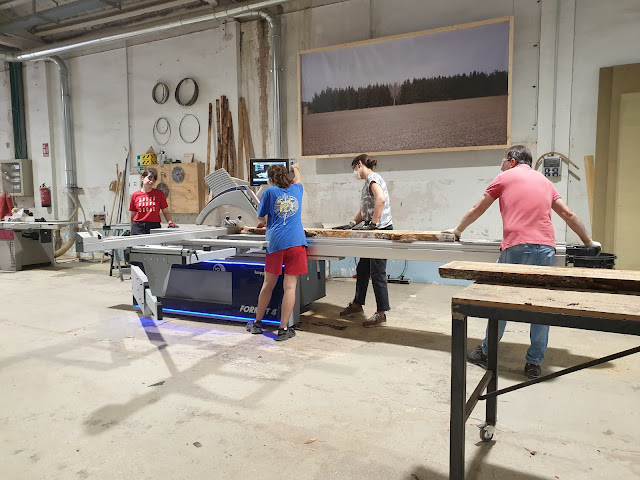





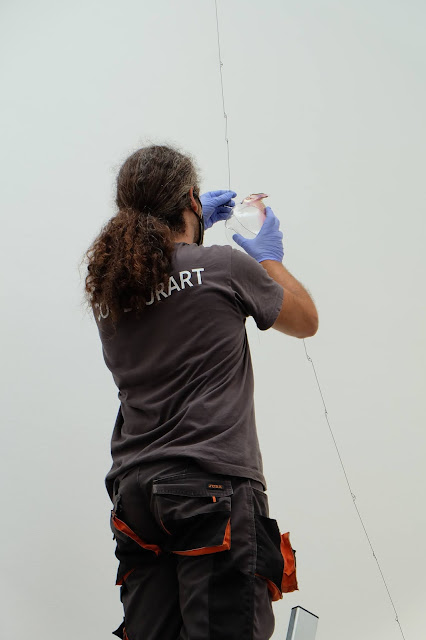






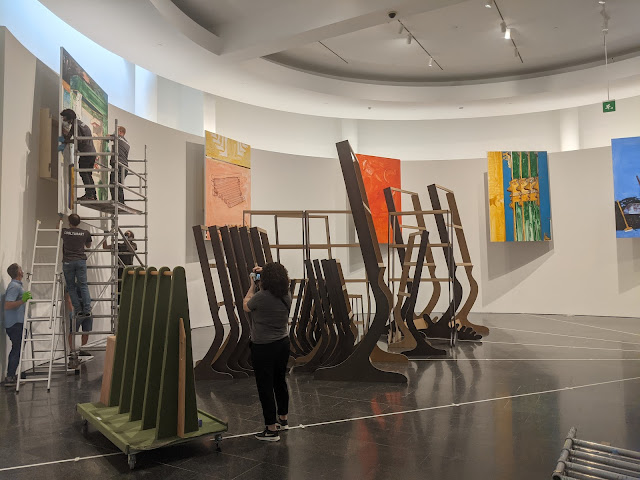

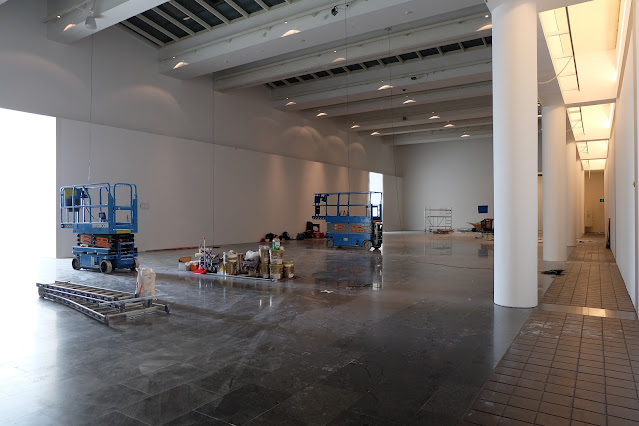





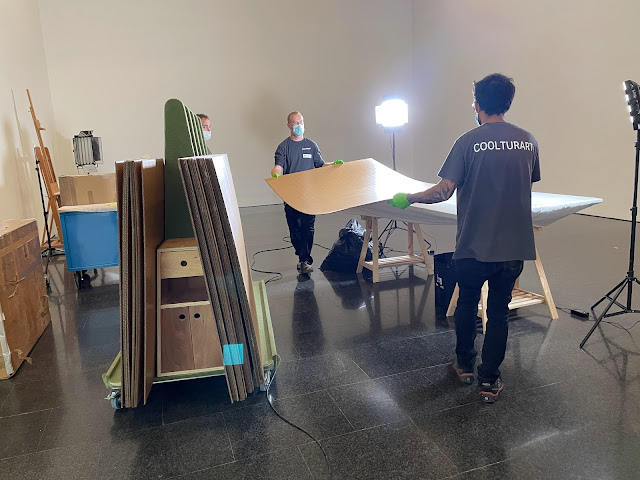




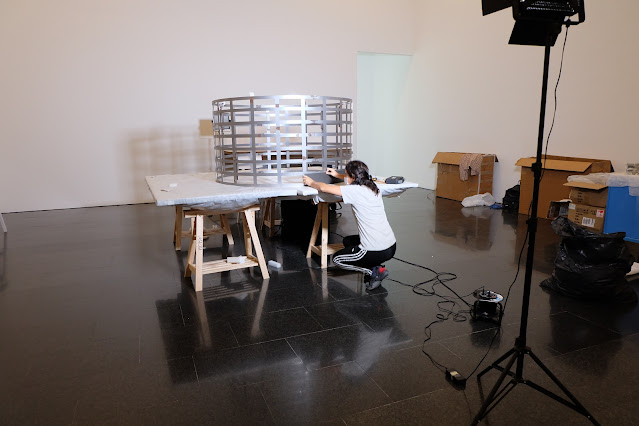
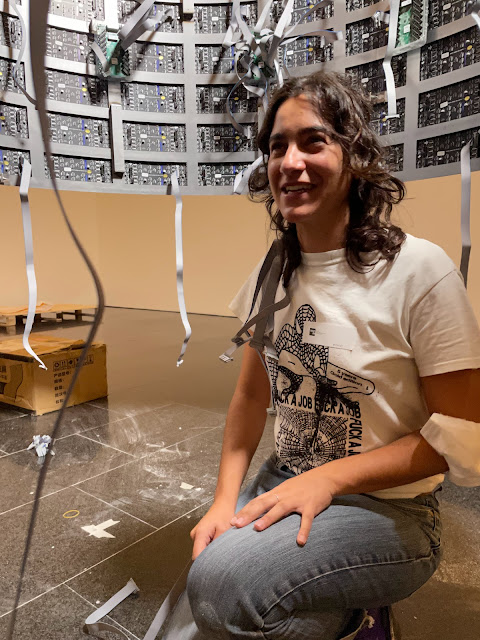
















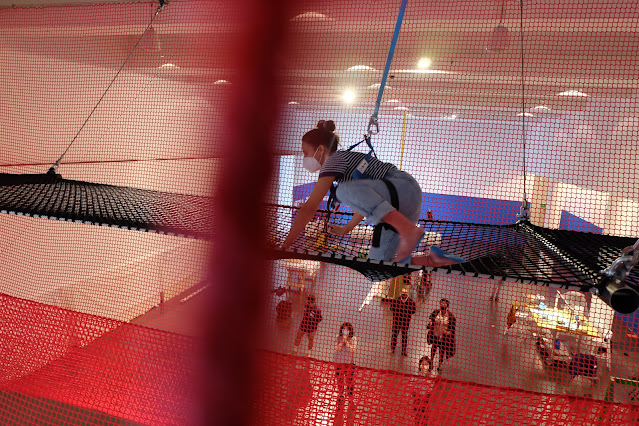











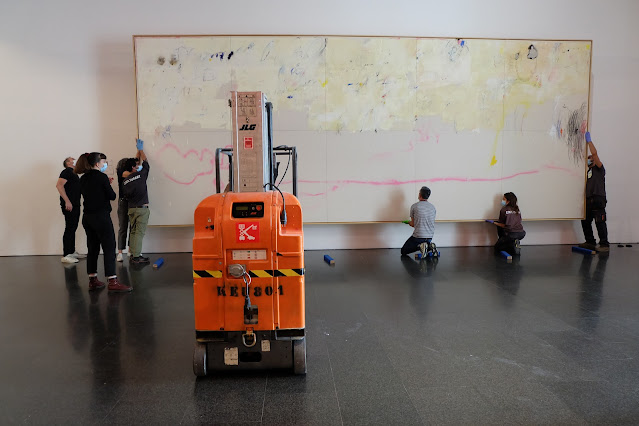



















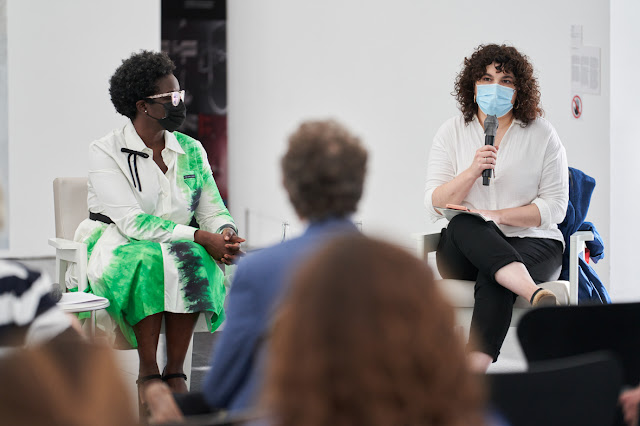


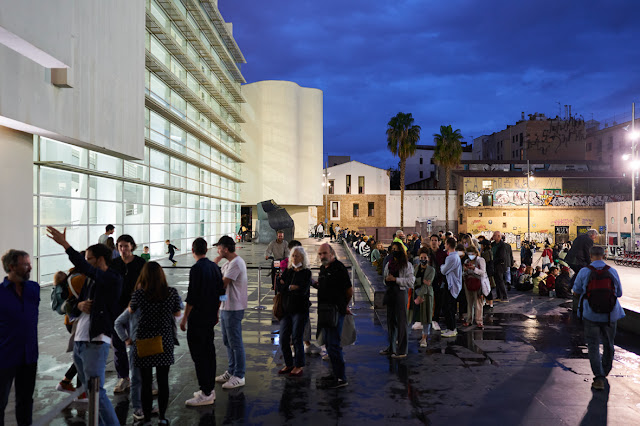









































































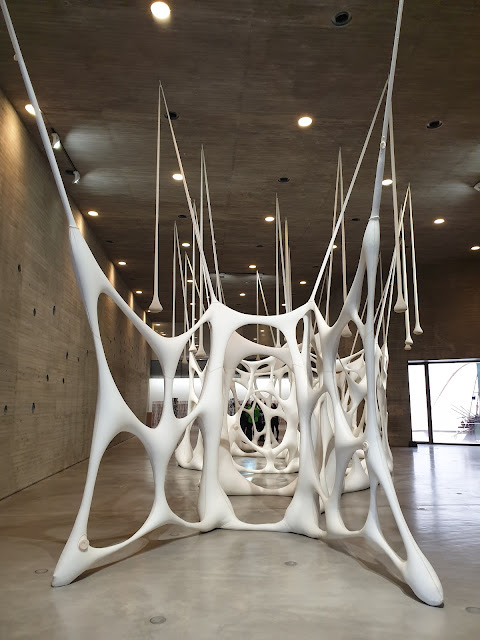
















%20SHELTER_Entering%20the%20work_2015-18_Obra%20realizada%20con%20la%20Ayuda%20Fundacio%CC%81n%20BBVA%20a%20la%20Creacio%CC%81n%20en%20Videoarte%202015____.jpg)








































































































